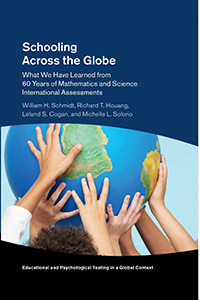A new book from Michigan State University’s William Schmidt recounts the history of international efforts to understand the role of schooling, in particular the curriculum, and its relationship to student achievement. It also gives the world insights to make test results more powerful for the future.
“Schooling Across the Globe: What We Have Learned from 60 Years of Mathematics and Science International Assessments,” published by Cambridge University Press, examines 17 international studies going back six decades.

Schmidt and his co-authors, MSU senior researchers Richard T. Houang and Leland S. Cogan and doctoral student Michelle L. Solorio, also provide 10 key findings with potential to improve schooling through the curriculum on a global scale; the result being better student learning as reflected in both curriculum and literacy assessments.
“The common themes covered in these studies is that the mathematics content kids study is a strong predictor of what they learn and what they achieve,” said Schmidt, University Distinguished Professor of education and statistics. “Secondly there is a tension between excellence and equity. Opportunities to learn are not evenly distributed. They are distributed in connection with social class, where the rich get richer and the poor get poorer opportunities to learn.”
The book offers one of the most comprehensive analyses of international education assessments to date, and the authors have firsthand experience developing some of these major studies.
For example, Schmidt was on the founding team for the Third International Mathematics and Science Study (TIMSS) in 1995, a precursor to the Trends in International and Science Study measuring what students learn in grades 4 and 8. TIMSS is administered by the International Association for the Evaluation of Educational Achievement (IEA).
Schmidt also has worked with the Organization for Economic Cooperation and Development (OECD) on the mathematics portions of the Program for International Student Assessment (PISA), which measures literacy levels among 15-year-olds.
“Interest in TIMSS, PIRLS and PISA shows no sign of abating—but all too often it is the headline-grabbing ‘league table of nations’ which is the focus of attention,” said Tim Oates, group director of assessment research and development at Cambridge Assessment in England. “There is, of course, so much more to the surveys than this. If there’s a definitive account which can improve understanding of how the surveys developed to where they are today, how they compare, and what the future holds, then this [book] is it.”
Leading change for PISA
Schmidt is currently leading a team of mathematicians, statisticians and mathematics educators that has been charged by OECD with creating an updated, broader definition of mathematical literacy including mathematical reasoning. This new framework will serve as the basis for the next PISA test, which focuses on math, in 2021.
“What PISA tests impacts what’s being taught in schools,” Schmidt said. “So this is an incredible opportunity to influence mathematical learning opportunities around the world.”
Hear more
Schmidt discusses the “Schooling Across the Globe” book on the Cambridge University Press podcast.





